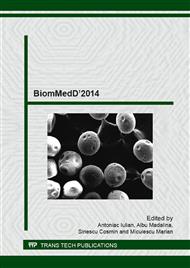p.111
p.117
p.123
p.130
p.135
p.141
p.145
p.151
p.155
Comparative Study to Determine the State of Tension Using FEM in a Premolar Restored with a Composite Inlay versus a Ceramic Inlay
Abstract:
The aesthetic composite inlay or ceramic ones are useful for restoring posterior teeth affected by decay processes. The choice of the inlay type can sometimes be a challenge for the dentist. The aim of this study is to identify the optimal type of an inlay used for second-class cavities that can assure a good long-term prognosis of dental restoration. In order to achieve this study, it was performed an 3D analysis of stresses recorded in a premolar restored with a composite inlay and a ceramic inlay, the simulation being done by finite elements method (FEM) using Ansys program. The study results showed that stresses registered in the tooth restored through ceramic inlay are more favorable than those recorded in the case of the tooth restored with composite inlay. The aesthetic composite inlays are preferred instead ceramic ones by many practitioners because of the advantages it presents: requires minimal preparations, technique is easier thanks to the easier handling of composite material, allow future adjustment of the occlusal surface, being easily adjusted and repaired, are radiopaque and, last but not least, have a lower cost. The question that arises frequently in medical practice is related to inlays behavior in case of functional requirements, depending on the material from which they are made. Configuration of preparation, the technique and the materials used for cementing, and restorative materials can influence the type of resistance to fracture of these restorations. The ability of restorative materials to support the masticatory forces and distribution of stresses in the vicinity of the adhesive interface constitutes a decisive factor in acquiring a restoration with a high degree of resistance to fracture.
Info:
Periodical:
Pages:
135-140
Citation:
Online since:
March 2015
Keywords:
Price:
Сopyright:
© 2015 Trans Tech Publications Ltd. All Rights Reserved
Share:
Citation:


